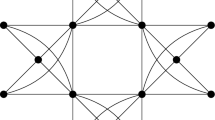Abstract
A graph is distance-hereditary if for any pair of vertices, their distance in every connected induced subgraph containing both vertices is the same as their distance in the original graph. The Distance-Hereditary Vertex Deletion problem asks, given a graph G on n vertices and an integer k, whether there is a set S of at most k vertices in G such that \(G-S\) is distance-hereditary. This problem is important due to its connection to the graph parameter rank-width because distance-hereditary graphs are exactly the graphs of rank-width at most 1. Eiben, Ganian, and Kwon (JCSS’ 18) proved that Distance-Hereditary Vertex Deletion can be solved in time \(2^{{\mathcal {O}}(k)}n^{{\mathcal {O}}(1)}\), and asked whether it admits a polynomial kernelization. We show that this problem admits a polynomial kernel, answering this question positively. For this, we use a similar idea for obtaining an approximate solution for Chordal Vertex Deletion due to Jansen and Pilipczuk (SIDMA’ 18) to obtain an approximate solution with \({\mathcal {O}}(k^3\log n+ k^2\log ^2 n)\) vertices when the problem is a Yes-instance, and we exploit the structure of split decompositions of distance-hereditary graphs to reduce the total size.






Similar content being viewed by others
Notes
Tree-width (or Tree-depth) w Vertex Deletion asks, given a graph G and an integer k, whether G contains a set S of at most k vertices such that \(G-S\) has tree-width (or tree-depth) at most w.
Theorem 3.4 of [18] presented one more condition that every complete bag is either fully or partially accessible, which is redundant by definition.
We mention that for our LP relaxation, found optimal solution has all rational values, each being represented using polynomial number of digits in n.
That applying kernelization twice can yield an improved bound was adequately observed in [2].
References
Adler, I., Kanté, M.M., Kwon, O.: Linear rank-width of distance-hereditary graphs I. A polynomial-time algorithm. Algorithmica 78(1), 342–377 (2017)
Agrawal, A., Lokshtanov, D., Misra, P., Saurabh, S., Zehavi, M.: Feedback vertex set inspired kernel for chordal vertex deletion. ACM Trans. Algorithms 15(1), 11–28 (2019)
Agrawal, A., Lokshtanov, D., Misra, P., Saurabh, S., Zehavi, M.: Polylogarithmic approximation algorithms for weighted-\(\cal{F}\)-deletion problems. ACM Trans. Algorithms 16(4), 5138 (2020)
Bandelt, H.-J., Mulder, H.M.: Distance-hereditary graphs. J. Combin. Theory Ser. B 41(2), 182–208 (1986)
Bouchet, A.: Transforming trees by successive local complementations. J. Graph Theory 12(2), 195–207 (1988)
Cheung, H.Y., Lau, L.C., Leung, K.M.: Algebraic algorithms for linear matroid parity problems. ACM Trans. Algorithms 10(3), 10:1-10:26 (2014)
Courcelle, B., Makowsky, J.A., Rotics, U.: Linear time solvable optimization problems on graphs of bounded clique-width. Theory Comput. Syst. 33(2), 125–150 (2000)
Courcelle, B., Olariu, S.: Upper bounds to the clique width of graphs. Discrete Appl. Math. 101(1–3), 77–114 (2000)
Cunningham, W.H., Edmonds, J.: A combinatorial decomposition theory. Canad. J. Math. 32(3), 734–765 (1980)
Dahlhaus, E.: Parallel algorithms for hierarchical clustering, and applications to split decomposition and parity graph recognition. J. Algorithms 36(2), 205–240 (2000)
Diestel, R.: Graph theory, volume 173 of Graduate Texts in Mathematics, 5th edn. Springer, Berlin (2017)
Eiben, E., Ganian, R., Kwon, O.: A single-exponential fixed-parameter algorithm for distance-hereditary vertex deletion. J. Comput. Syst. Sci. 97, 121–146 (2018)
Erdős, P., Pósa, L.: On independent circuits contained in a graph. Canad. J. Math. 17, 347–352 (1965)
Eschen, E.M., Hoàng, C.T., Spinrad, J.P., Sritharan, R.: On graphs without a \(C_4\) or a diamond. Discrete Appl. Math. 159(7), 581–587 (2011)
Farber, M.: On diameters and radii of bridged graphs. Discrete Math. 73(3), 249–260 (1989)
Fomin, F.V., Lokshtanov, D., Misra, N., Saurabh, S.: Planar F-deletion: approximation, kernelization and optimal FPT algorithms. In: 2012 IEEE 53rd Annual Symposium on Foundations of Computer Science—FOCS 2012, pp. 470–479. IEEE Computer Soc., Los Alamitos (2012)
Giannopoulou, A.C., Jansen, B.M.P., Lokshtanov, D., Saurabh, S.: Uniform kernelization complexity of hitting forbidden minors. ACM Trans. Algorithms 13(3), 3535 (2017)
Gioan, E., Paul, C.: Split decomposition and graph-labelled trees: characterizations and fully dynamic algorithms for totally decomposable graphs. Discrete Appl. Math. 160(6), 708–733 (2012)
Gupta, A.: Improved results for directed multicut. In: Proceedings of the Fourteenth Annual ACM-SIAM Symposium on Discrete Algorithms, SODA 2003, January 12–14, 2003, Baltimore, Maryland, USA, pp. 454–455 (2003)
Howorka, E.: A characterization of distance-hereditary graphs. Quart. J. Math. Oxford Ser. (2) 28(112), 417–420 (1977)
Jansen, B.M.P., Pilipczuk, M.: Approximation and kernelization for chordal vertex deletion. SIAM J. Discrete Math. 32(3), 2258–2301 (2018)
Kanté, M.M., Kim, E.J., Kwon, O., Paul, C.: An FPT algorithm and a polynomial kernel for linear rankwidth-1 vertex deletion. Algorithmica 79(1), 66–95 (2017)
Kim, E.J., Langer, A., Paul, C., Reidl, F., Rossmanith, P., Sau, I., Sikdar, S.: Linear kernels and single-exponential algorithms via protrusion decompositions. ACM Trans. Algorithms 12(2), 2141 (2016)
Leighton, F.T., Rao, S.: Multicommodity max-flow min-cut theorems and their use in designing approximation algorithms. J. ACM 46(6), 787–832 (1999)
Lewis, J.M., Yannakakis, M.: The node-deletion problem for hereditary properties is NP-complete. J. Comput. Syst. Sci. 20(2), 219–230 (1980)
Lovász, L.: Matroid matching and some applications. J. Combin. Theory Ser. B 28(2), 208–236 (1980)
Orlin, J.B.: A fast, simpler algorithm for the matroid parity problem. In: Integer Programming and Combinatorial Optimization, 13th International Conference, IPCO 2008, Bertinoro, Italy, May 26–28, 2008, Proceedings, pp. 240–258 (2008)
Oum, S.: Rank-width and vertex-minors. J. Combin. Theory Ser. B 95(1), 79–100 (2005)
Author information
Authors and Affiliations
Corresponding author
Additional information
Publisher's Note
Springer Nature remains neutral with regard to jurisdictional claims in published maps and institutional affiliations.
The first author was supported by ANR under ANR Blanc program (ESIGMA: ANR-17-CE23-0010) and ANR JCJC program (ASSK: ANR-18-CE40-0025-01). The second author was supported by the European Research Council (ERC) under the European Union’s Horizon 2020 research and innovation programme (ERC consolidator Grant DISTRUCT, Agreement No. 648527), supported by the National Research Foundation of Korea (NRF) Grant funded by the Ministry of Education (No. NRF-2018R1D1A1B07050294), and supported by the Institute for Basic Science (IBS-R029-C1).
Rights and permissions
About this article
Cite this article
Kim, E.J., Kwon, Oj. A Polynomial Kernel for Distance-Hereditary Vertex Deletion. Algorithmica 83, 2096–2141 (2021). https://doi.org/10.1007/s00453-021-00820-z
Received:
Accepted:
Published:
Issue Date:
DOI: https://doi.org/10.1007/s00453-021-00820-z




